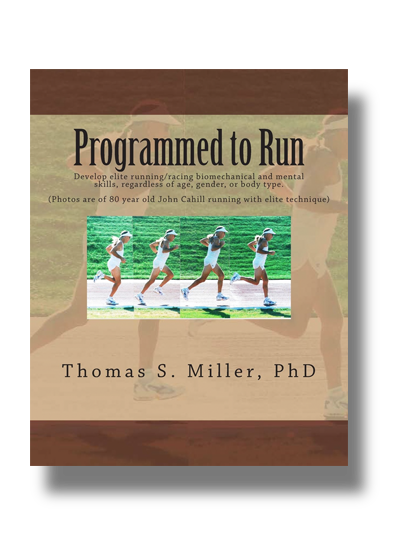Reviewed by Don Allison
Just about every top runner has penned a “how to” running book it seems, from Bill Rodgers to Grete Waitz, Jeff Galloway, and Uta Pippig. Invariably, these books follow a formulatic approach, focusing on most basic aspects of the sport, most of which are familiar to runners with even a modest amount of experience.
One area in which almost all “how to” running books are lacking is the subject of running biomechanics. That void is surely due to the fact that biomechanics is the most difficult aspect of distance running to fully understand and properly explain to a reader. In his book Programmed to Run, author Thomas Miller does more than a credible job of doing just that.
Although not specifically written for ultrarunners, there is a plethora of useable material for them in Programmed to Run. Delving deep into the theory and implementation of biomechanics, Miller employs a readable style, explaining the importance of proper mechanics in distance running. If you wonder how important biomechanical efficiency is in distance running, stand at the finish line of any road race and watch the progression of runners as they come in. Aside from raw physical fitness, you will witness the huge advantage that superb biomechanics offers elite runners over the “middle of the pack” finishers.
The point that Miller continues to drive home throughout Programmed to Run is that most novice runners (and even some with years of experience) overstride, causing all sorts of biomechanical inefficiencies, primarily because the body’s center of gravity is too far forward during the landing phase of the stride and the resulting push off. In order to ameliorate this potential problem, Miller suggests we only look at elite Kenyan distance runners. Their slight forward lean (something many coaches discourage) allows them to keep their center of gravity properly balanced and thus run with the most efficient stride possible. Miller stresses that even small corrections and improvements in one’s running mechanics can result in improved performance.
Aside from optimal running biomechanics, mental preparation, performance goals and even “psychomechanics” are other subjects addressed in impressive detail in Programmed to Run. Although Miller does a more than adequate job presenting this material, the real value of this book comes early on in the pages devoted to biomechanics.
Rarely has this topic been so thoroughly covered in one running book. Although Miller has run more than 100 marathons, he readily admits that he is less than a world-class runner himself. He has shown in Programmed to Run however, that he knows proper running form—and how too convey those principles to the reader. In actuality, that skill is as rare as the ability to run a 2:08 marathon.


Leave a Reply